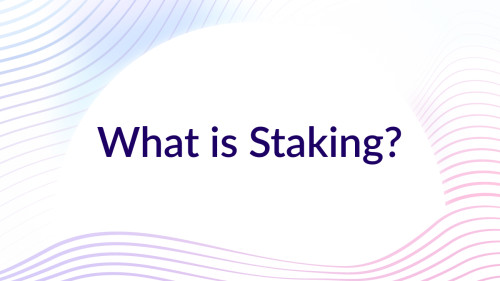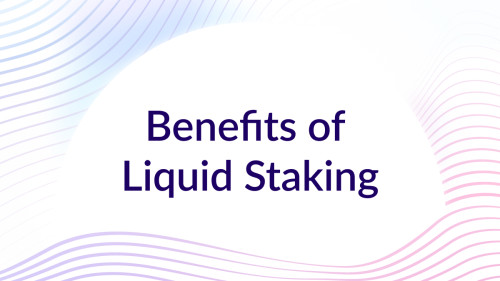
Dashboard
Stake
Unstake
VNO
What is Liquid Staking?
💭 Purchased CRO and just been monitoring the price chart?
💭 Want to start exploring DeFi but don’t know where to start?
💭 Ready to supercharge your DeFi journey and earn more?
Explore Liquid Staking and unlock exciting opportunities to boost your profits. Keep reading to learn how it can maximize your earnings.
What is Staking?

Before discussing liquid staking, we should understand the basic concept and benefits of staking.
🔒 Staking refers to validators locking up a proof-of-stake network's native cryptocurrency tokens to be eligible for validation duties, which involve validating transactions on the blockchain in a randomized process. In return, validators earn rewards in the form of network fees paid by the users.
Unlike proof-of-work networks, there is no mining or block rewards in proof-of-stake. New tokens are not generated through inflation to pay staking rewards. All staking yields and rewards come directly from the network fees paid by users of the network for using dapps and transferring value. No new tokens are created from inflation. Hence the staking yields are real yields in the sense that they represent a portion of the value transferred on the network, not inflated token supply. In comparison, some other non-inflationary proof-of-stake networks may distribute tokens as staking rewards that were pre-mined at genesis or through inflation.
Importance of Staking
⛓️ Staking plays a key role in securing proof-of-stake blockchains and contributing to the overall security of the network. It utilizes an economic model with penalties and rewards to motivate proper behavior from participants and strengthen the underlying security. Requiring validators to stake their own holdings encourages them to act in the best interests of the network.
However, with traditional staking methods, you cannot utilize the staked tokens for other yield-generating opportunities on dApps since they remain locked up. There are often lock-up periods before the staked tokens can be withdrawn for other purposes, resulting in limited liquidity of your tokens.
What is Liquid Staking?

💧Liquid staking services accept token deposits from users, stake those funds on the users' behalf, and issue them a receipt in the form of a new crypto token representing their position ("Liquid Staked Tokens" or LST). This LST can be redeemed for the originally staked tokens plus or minus a portion of any rewards or penalties earned. More importantly, the LST is liquid and can be traded or used as collateral on DeFi protocols. This unlocks the value of the staked assets by allowing users to generate additional yields on other DeFi protocols while still benefiting from staking rewards from the underlying tokens.
Benefits of Liquid Staking

🫴 Unlocked Value: Liquid staked tokens allow access to the value of staked funds by making them tradable and usable as collateral in DeFi, allowing users to earn additional rewards.
💰 Compound Rewards: Liquid staking maintains staking income while enabling yields from multiple DeFi protocols, benefiting from returns compounding over time.
✅ Accessibility: Liquid staking services allow anyone to partake in staking rewards without needing to manage complex validator infrastructure. For example, users can participate in ETH staking even if they do not hold the minimum 32 ETH required to independently validate.
Risks and Limitations of Liquid Staking

💡 Slashing Risk: By outsourcing validator node management to a third party, users bear the risk of potential funds slashing if the operator acts maliciously or performs unreliably.
💡 Exploit Vulnerability: Tokens deposited with a liquid staking provider are subject to risks if the operator suffers a private key compromise or a smart contract exploit arises in the protocol.
💡 Market Volatility: Unlike being pegged to the underlying asset, the price of liquid staking tokens can fall below the asset value during liquidity shortfalls or unexpected events. With typically lower trading volumes than the asset itself, market shocks may cause disproportionate volatility in the staked tokens.
It is important to note that liquid staking operators take on the responsibility of selecting the validator nodes to delegate the tokens to, reducing the due diligence work to be done by the end users who want to participate in staking.
What is Veno Finance?

Veno Finance is a liquid staking protocol on Cronos and zkSync Era where you can stake your CRO, ATOM, and ETH, and receive the auto-compounding, yield-bearing liquid staked tokens (LCRO, LATOM, LETH). They are designed to maximize composability. Just by owning the liquid tokens, you automatically accrue the staking yield value in your liquid token; the liquid tokens can thus be used freely across the DeFi ecosystem on both chains.
Why stake with Veno?
🔹 Cost savings are achieved by leveraging our own node infrastructure and/or infrastructure of our partners
🔹 Reliability is achieved with our enterprise-grade node set-up, deep expertise in running node infrastructure, with our smart contracts being audited by external party SlowMist.
🔹 Insurance module can help to secure user funds in the unlikely event of a slashing penalty.
🔹 Swap out of the liquid staked tokens on our partner protocols anytime if you want to gain immediate access to the underlying token.
We currently support the following network and tokens:
Cronos: CRO and ATOM Staking
zkSync Era: ETH Staking
Stake with Veno now to earn up to 16% APY staking rewards while utilizing your LSTs to earn even more on other DeFi protocols!
💰 Stake now 💰
🧠 Take this quiz to test yourself 🧠
DISCLAIMER. THE INFORMATION AND CONTENT ON THIS PAGE IS STRICTLY FOR INFORMATIONAL PURPOSES ONLY. Nothing contained herein shall constitute or be construed as solicitation, recommendation, endorsement, or offer, nor as implicit or explicit investment advice or investment recommendations by Veno Finance. You agree that it is your sole responsibility to carry out all necessary due diligence. DO YOUR OWN RESEARCH.

